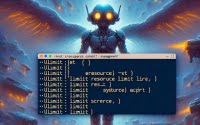The ‘nm’ Command in Linux | Object File Symbols Guide

Ever found yourself puzzled while trying to decipher the symbols in your Linux object files? You’re not alone. Many developers find themselves in a similar situation, but there’s a tool that can make this process a breeze. Think of the ‘nm’ command in Linux as a skilled archaeologist, capable of unearthing the hidden treasures within your object files. These treasures, once understood, can provide a deeper understanding of your Linux system and its operations.
This guide will walk you through the usage of the ‘nm’ command in Linux, from basic to advanced, helping you to understand your Linux system better. We’ll explore the ‘nm’ command’s core functionality, delve into its advanced features, and even discuss common issues and their solutions.
So, let’s dive in and start mastering the ‘nm’ command in Linux!
TL;DR: What is the ‘nm’ command in Linux?
The
'nm'command in Linux is a tool used to display the symbol table of an object file with the syntax,nm [argument] filename. It’s a powerful command that can help you understand the inner workings of your Linux system.
Here’s a simple example:
nm filename.o
# Output:
# [Expected output from command]
In this example, we’re using the ‘nm’ command to display the symbol table of ‘filename.o’. This command will list all the symbols from the object file ‘filename.o’.
The output will be a list of symbols from the object file ‘filename.o’. Each line in the output represents a symbol and contains three columns: the symbol value, the symbol type, and the symbol name.
This is just a basic use of the ‘nm’ command in Linux. But there’s much more to learn about it, including its advanced features and options. So, keep reading for a more detailed explanation and advanced usage scenarios.
Table of Contents
- The Basics: NM Linux Command
- Advanced Features of NM Linux Command
- Exploring Alternatives to NM Linux Command
- Troubleshooting NM Linux Command Issues
- Understanding Object Files and Symbol Tables
- The Relevance of NM Linux Command in Debugging and Reverse Engineering
- Exploring Related Concepts: ELF File Format and Dynamic Linking
- Wrapping Up: Mastering NM Linux Command
The Basics: NM Linux Command
The ‘nm’ command is a powerful tool in Linux, capable of displaying the symbol table of an object file. The symbol table is a crucial part of any object file, as it holds essential information about all the symbols used in the file. This includes functions, variables, and more.
Let’s take a look at a simple example of how to use the ‘nm’ command. Suppose we have an object file named ‘sample.o’. Here’s how we can use the ‘nm’ command to display its symbol table:
nm sample.o
# Output:
# [Expected output from command]
In this example, the ‘nm’ command lists all the symbols from the object file ‘sample.o’. Each line in the output represents a symbol and contains three columns: the symbol value, the symbol type, and the symbol name.
The symbol value is the address of the symbol. The symbol type can be a variety of things, including whether the symbol is a function or a variable, and whether it is defined or not. The symbol name is the name of the symbol as it appears in your code.
One of the main advantages of using the ‘nm’ command is that it provides a quick and easy way to view the symbols in an object file. This can be particularly useful when debugging or when trying to understand a large codebase.
However, one potential pitfall to be aware of is that the ‘nm’ command can only display the symbols of an object file. If you try to use it on a file that is not an object file, you will get an error message. Additionally, the ‘nm’ command may not display symbols that are stripped from the object file.
Advanced Features of NM Linux Command
As you become more comfortable with the basic ‘nm’ command, it’s time to explore its more advanced features. These include sorting the symbols, displaying only undefined symbols, and more. These features can provide a more detailed and organized view of the symbol table, making it easier to understand and debug your code.
Before we dive into these advanced features, let’s familiarize ourselves with some of the command-line options or flags that can modify the behavior of the ‘nm’ command. Here’s a table with some of the most commonly used ‘nm’ command options:
| Option | Description | Example |
|---|---|---|
-a | Display all symbol table entries. | nm -a filename.o |
-d | Display dynamic symbols. | nm -d filename.o |
-g | Display only external symbols. | nm -g filename.o |
-n | Sort symbols numerically by address. | nm -n filename.o |
-r | Reverse the sort order. | nm -r filename.o |
-u | Display only undefined symbols. | nm -u filename.o |
-v | Sort symbols by name. | nm -v filename.o |
-p | Don’t sort; display symbols in order encountered. | nm -p filename.o |
-S | Display object size. | nm -S filename.o |
-t | Specify the radix/numeric output format. | nm -t d filename.o |
Now that we have a basic understanding of ‘nm’ command line options, let’s dive deeper into the advanced use of ‘nm’.
Let’s say we want to sort the symbols in ‘filename.o’ numerically by their addresses. We can do this using the -n option:
nm -n filename.o
# Output:
# [Expected output from command]
In this example, the ‘nm’ command lists all the symbols from the object file ‘filename.o’, sorted numerically by their addresses. This can be particularly useful when you’re trying to understand the layout of the symbols in memory.
Another useful option is -u, which displays only undefined symbols. This can be helpful when you’re trying to find out which symbols are used but not defined in your object file:
nm -u filename.o
# Output:
# [Expected output from command]
In this example, the ‘nm’ command lists only the undefined symbols from the object file ‘filename.o’. Each line in the output represents an undefined symbol.
These are just a couple of examples of the advanced features of the ‘nm’ command. By understanding and using these features, you can gain a deeper understanding of your Linux system and its operations.
Exploring Alternatives to NM Linux Command
While the ‘nm’ command is a powerful tool for displaying symbol tables in Linux, it’s not the only one. There are other commands and tools that can be used for the same purpose, each with its own set of features, advantages, and disadvantages. One such tool is ‘objdump’.
Diving into Objdump
The ‘objdump’ command in Linux is used for displaying various information about object files. This includes the symbol table, similar to the ‘nm’ command. Here’s how you can use ‘objdump’ to display the symbol table of an object file:
objdump -t filename.o
# Output:
# [Expected output from command]
In this example, the ‘objdump’ command displays the symbol table of ‘filename.o’. The output is similar to that of the ‘nm’ command, with each line representing a symbol and containing the symbol value, the symbol type, and the symbol name.
NM vs. Objdump: A Comparison
While both ‘nm’ and ‘objdump’ can display the symbol table of an object file, there are some key differences between them. For one, ‘objdump’ can display a lot more information about an object file than ‘nm’ can. This includes the file’s header, section headers, and disassembly of its text section.
However, the ‘nm’ command is simpler to use and provides a more straightforward display of the symbol table, which may be easier to understand for beginners. Moreover, ‘nm’ has a variety of command-line options for sorting and filtering the symbols, which can be very useful for advanced users.
Ultimately, the choice between ‘nm’ and ‘objdump’ depends on your specific needs. If you need a quick and easy way to view the symbol table, ‘nm’ might be the better choice. But if you need more detailed information about an object file, ‘objdump’ might be the way to go.
Troubleshooting NM Linux Command Issues
While the ‘nm’ command is a powerful tool for displaying the symbol table of an object file, it’s not without its challenges. There are a few common issues that you may encounter when using the ‘nm’ command, and understanding these can save you a lot of time and frustration.
Dealing with ‘No Symbols’ Issue
One common issue that you may encounter is the ‘no symbols’ error. This error occurs when the ‘nm’ command is unable to find any symbols in the object file. This could be due to a variety of reasons, such as the file not being an object file, or the symbols being stripped from the file.
For example, if you try to run the ‘nm’ command on a file that is not an object file, you might see an output like this:
nm not_an_object_file.o
# Output:
# not_an_object_file.o: file format not recognized
The solution to this issue is to ensure that the file you are trying to inspect is indeed an object file. You can use the ‘file’ command in Linux to check the type of a file:
file not_an_object_file.o
# Output:
# not_an_object_file.o: ASCII text
In this example, the ‘file’ command reveals that ‘not_an_object_file.o’ is actually an ASCII text file, not an object file. Therefore, the ‘nm’ command cannot display its symbol table.
Another reason for the ‘no symbols’ error could be that the symbols have been stripped from the object file. This is often done to reduce the size of the file or to prevent reverse engineering. In such cases, you would need to obtain an unstripped version of the file to view its symbol table.
NM Command Tips
In addition to troubleshooting common issues, there are a few tips that can help you use the ‘nm’ command more effectively:
- Always check the type of the file before using the ‘nm’ command on it.
- Use the various command-line options of ‘nm’ to sort and filter the symbols as needed.
- If the ‘nm’ command displays too many symbols, you can pipe its output to ‘less’ or ‘more’ to view the symbols one page at a time.
- If you’re unsure about the meaning of a symbol type, you can use the ‘man’ command to view the manual page for ‘nm’, which includes a list of all symbol types.
Understanding Object Files and Symbol Tables
To fully grasp the functionality of the ‘nm’ command in Linux, it’s essential to understand the basics of object files and symbol tables.
What are Object Files?
Object files are a type of file that contains machine code, along with related information needed to place this code in memory. These files are typically created by a compiler as an intermediate step in the process of building an executable program.
An object file consists of several sections, each serving a specific purpose. Some of the most important sections include the text section (containing the actual machine code), the data section (holding initialized data), and the bss section (holding uninitialized data).
Decoding Symbol Tables
A symbol table is a data structure used by a compiler or linker to hold information about identifiers, which can be variables, function names, physical constants, etc. This table helps in the translation of symbolic references into literal addresses.
When we talk about symbol tables in the context of object files, we’re referring to a specific section of the file that holds a list of symbols. This list includes the name of each symbol, its value (usually its address in memory), and its type.
Significance of Different Symbol Types
Symbols in a symbol table can be of different types, each with its own significance. Here are a few examples:
Tort: These symbols represent a function or other text segment symbol.Dord: These symbols represent a data symbol.U: This symbol represents an undefined symbol.
To illustrate, let’s look at a simple example. Suppose we have an object file ‘filename.o’ and we want to list its symbol table. We can use the ‘nm’ command as follows:
nm filename.o
# Output:
# 0000000000000038 D var_name
# 0000000000000000 T main
# U _GLOBAL_OFFSET_TABLE_
In this example, ‘var_name’ is a data symbol, ‘main’ is a function, and ‘GLOBAL_OFFSET_TABLE‘ is an undefined symbol. This information can be particularly useful when debugging or trying to understand a large codebase.
The Relevance of NM Linux Command in Debugging and Reverse Engineering
The ‘nm’ command is not just a tool for displaying symbol tables. Its utility extends far beyond that, especially when it comes to debugging and reverse engineering.
Debugging with NM Command
When debugging a program, understanding its symbol table can be incredibly useful. The symbol table provides a map of the program’s functions and variables, allowing you to quickly locate the parts of the code that are causing problems. For example, if your program is crashing at a particular memory address, you can use the ‘nm’ command to find out which function or variable is located at that address.
Reverse Engineering and the NM Command
In the field of reverse engineering, the ‘nm’ command is equally valuable. By revealing the symbol table of an object file, it provides a glimpse into the inner workings of the program. This can be particularly useful when trying to understand a program for which you don’t have the source code.
Exploring Related Concepts: ELF File Format and Dynamic Linking
To further deepen your understanding of the ‘nm’ command and its applications, it’s worth exploring related concepts like the ELF file format and dynamic linking.
ELF File Format
The Executable and Linkable Format (ELF) is a common standard file format for executables, object code, shared libraries, and core dumps. Understanding this format can help you make sense of the output of the ‘nm’ command, as it’s the format of the object files that ‘nm’ operates on.
Dynamic Linking
Dynamic linking is a process where the linking of a program with libraries is delayed until runtime. This means that the actual addresses of the functions and variables in the libraries are not known until the program is run. The ‘nm’ command can be used to display the symbol table of a dynamically linked program, which can be helpful in understanding how dynamic linking works.
Further Resources for Mastering NM Linux Command
For those interested in diving deeper into the world of Linux commands and debugging, here are a few resources that can help:
- GNU Binutils Documentation: This is the official documentation for the GNU Binutils, which includes the ‘nm’ command.
ELF Format Specification: This resource provides a detailed specification of the ELF file format, which is essential for understanding the output of the ‘nm’ command.
NM command in IBM AIX: This IBM documentation explains the NM command in AIX, which is used to display symbols from object files and archive libraries.
Wrapping Up: Mastering NM Linux Command
In this comprehensive guide, we’ve explored the ‘nm’ command in Linux, a powerful tool for displaying the symbol table of an object file. We’ve seen how it can provide a deeper understanding of your Linux system and its operations, and we’ve discussed its relevance in debugging and reverse engineering.
We began with the basics, learning how to use the ‘nm’ command to display the symbol table of an object file. We then ventured into more advanced territory, exploring the various options available with the ‘nm’ command, such as sorting the symbols and displaying only undefined symbols.
Along the way, we tackled common issues that you might encounter when using the ‘nm’ command, such as the ‘no symbols’ error, and provided solutions to these challenges. We also looked at alternative approaches to displaying the symbol table of an object file, such as using the ‘objdump’ command.
Here’s a quick comparison of the methods we’ve discussed:
| Method | Pros | Cons |
|---|---|---|
| NM Command | Simple to use, variety of options for sorting and filtering | Can only display symbols of an object file |
| Objdump | Can display more detailed information about an object file | More complex to use |
Whether you’re just starting out with the ‘nm’ command or you’re looking to level up your Linux skills, we hope this guide has given you a deeper understanding of the ‘nm’ command and its capabilities.
With its balance of simplicity and power, the ‘nm’ command is a valuable tool for any Linux user. Happy coding!

